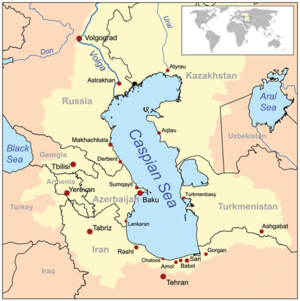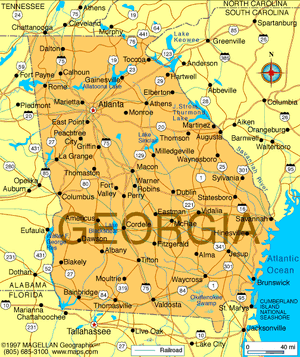Darial
| Author: Laxman Burdak, IFS (R) |

Darial is a river gorge on the border between Russia and Georgia.
Variants
- Darial Gorge (Georgian: დარიალის ხეობა, Darialis Kheoba; Russian: Дарьяльское ущелье; Ossetian: Арвыком, Arvykom; Ingush: Даьра Аьле, Dära Äle; Chechen: Теркан чӀаж, Terkan ch'azh)
- Darialani
- Dar-i Alān (در الان) meaning "Gate of the Alans" in Persian.
- Gates of Caucasus (by Pliny)
Location
It is at the east base of Mount Kazbek, south of present-day Vladikavkaz. The gorge was carved by the river Terek, and is approximately 13 kilometres long.
Origin
The Darial originates from Dar-i Alān (در الان) meaning "Gate of the Alans" in Persian. The Alans held the lands north of the pass in the first centuries AD.
Jat clans
History
It has been fortified in ancient times by the Romans and Persians; the fortification was variously known as the Iberian Gates[2] or the Caucasian Gates.[3] The pass is mentioned in the Georgian annals under the names of Darialani; Strabo calls it Porta Caucasica and Porta Cumana; Ptolemy, Fortes Sarmatica; it was sometimes known as Porta Caucasica and Portae Caspiae (a name bestowed also on the "gate" or pass beside the Caspian Sea at Derbent); and the Tatars call it Darioly.[4][5]
Josephus wrote that Alexander the Great built iron gates at an unspecified pass[6]which some Latin and Greek authors identified with Darial.[7]
Darial Pass fell into Sassanid hands in 252–253, when the Sassanid Empire conquered and annexed Iberia.[8] The control of the Darial Pass switched to the Western Turkic Kaganate in 628, when Tong Yabgu Kagan signed a treaty with Iberia, transferring over to the Kaganate the control of all its cities and fortresses, and establishing free trade.[9] Control of Darial Pass switched to the Arab Rashidun Caliphate in 644.[10] Afterwards, it was controlled by the Kingdom of Georgia. There was a battle point between the Ilkhanate and the Golden Horde, then indirectly controlled by Safavids and Qajar state, until it was captured by Russian Empire after annexation of Kingdom of Georgia in 1801–1830. It remained a strategic Russian forepost under Russian control until the dismemberment of the Soviet Union.
Mention by Pliny
Pliny[11]mentions about Gates of Caucasus ....After passing the last, we come to the Gates of Caucasus1, by many persons most erroneously called the Caspian Passes; a vast work of nature, which has suddenly wrenched asunder in this place a chain of mountains. At this spot are gates barred up with beams shod with iron, while beneath the middle there runs a stream which emits a most fetid odour; on this side of it is a rock, defended by a fortress, the name of which is Cumania2, erected for the purpose of preventing the passage of the innumerable tribes that lie beyond. Here, then, we may see the habitable world severed into two parts by a pair of gates; they are just opposite to Harmastis, a town of the Iberi.
1. There are two chief passes over the chain of the Caucasus, both of which were known to the ancients. The first is between the eastern extremity of its chief north-eastern spur and the Caspian Sea, near the modern Derbend. This was called "Albaniæ," and sometimes, "Caspiæ Pylie," the "Albanian" or "Caspian Gates." The other, which was nearly in the centre of the Caspian range, was called "Caucasiæ" or "Sarmaticæ Pylæ," being the same as the modern pass of Dariyel, and probably the one here referred to.
2. Probably the same as the present fortress of Dariyel.
Importance
The Darial Pass was historically important as one of only two crossings of the Caucasus mountain range, the other being the Derbent Pass. As a result, Darial Gorge has been fortified since at least 150 BC.[12] Ruins of an ancient fortress are still visible. The pass served as a hub point for many roads connecting North and South Caucasus and remained open for traffic for most of its existence.
The Russian fort, Darial, which guarded this section of the Georgian Military Road, was built at the northern end of the gorge, at an altitude of 1,447 metres (4,747 ft).
The gorge has been immortalized in Russian poetry, notably by Lermontov in The Demon; it has become known as one of the most romantic places in the Caucasus.
As the main border crossing between Georgia Russia, it has been the site of Russians fleeing conscription for the Russo-Ukrainian War.[13]
References
- ↑ Natural History by Pliny Book VI/Chapter 12
- ↑ "Garrison of the Iberians" (Greek: Iouroeipaach, Biraparach, from Armenian) https://iranicaonline.org/articles/darband-i-ancient-city
- ↑ Scheffel, Richard L.; Wernet, Susan J., eds. (1980). Natural Wonders of the World. United States of America: Reader's Digest Association, Inc. pp. 116. ISBN 0-89577-087-3.
- ↑ Chisholm, Hugh, ed. (1911). "Darial". Encyclopædia Britannica. Vol. 7 (11th ed.). Cambridge University Press. p. 832.
- ↑ Van Donzel, Emeri J.; Schmidt, Andrea Barbara (2010). Gog and Magog in Early Eastern Christian and Islamic Sources: Sallam's Quest for Alexander's Wall. Brill. ISBN 978-9004174160. pp. 51–52.
- ↑ Van Donzel, Emeri; Andrea Schmidt (2010). Gog and Magog in Early Syriac and Islamic Sources: Sallam's Quest for Alexander's Wall. Brill Academic Publishers. p. 11. ISBN 978-9004174160.
- ↑ Reynolds, Gabriel Said (2007). The Qur'an in its Historical Context. Routledge. p. 186. ISBN 978-0415428996.
- ↑ Ehsan Yarshater. The Cambridge history of Iran, Volume 1. Cambridge University Press, 1983. ISBN 0-521-20092-X, 9780521200929, p. 141
- ↑ Movses Kagankatvatsi. History of Agvans (Russian trans. and ed. by Patkanov). St. Petersburg, 1861, pp. 121
- ↑ Akram A.I. The Muslim Conquest of Persia, Ch:16 ISBN 978-0-19-597713-4
- ↑ Natural History by Pliny Book VI/Chapter 12
- ↑ Chisholm, Hugh, ed. (1911). "Darial". Encyclopædia Britannica. Vol. 7 (11th ed.). Cambridge University Press. p. 832.
- ↑ Ivanova, Ksenia; Porter, Catherine (2022-10-01). "Panic, Bribes, Ditched Cars and a Dash on Foot: Portraits of Flight From Russia". The New York Times. ISSN 0362-4331.
Back to Central Asia
